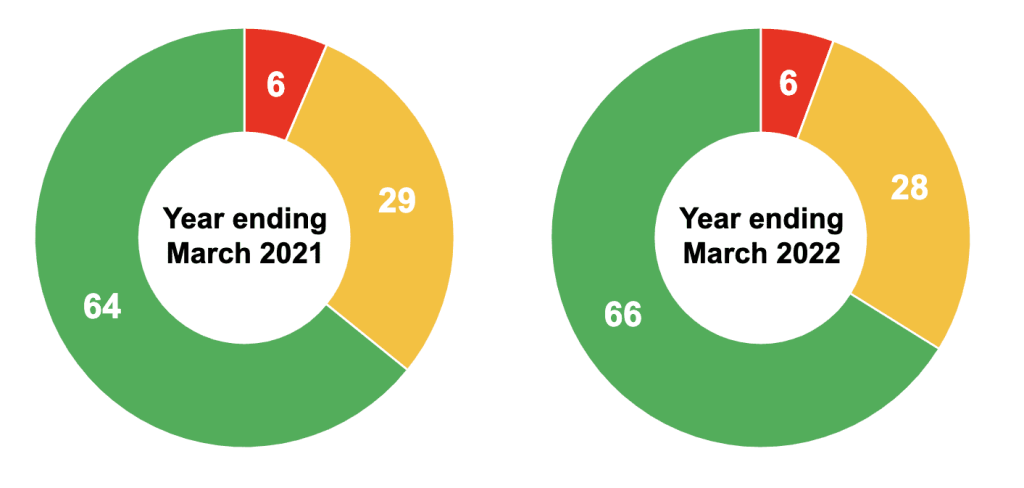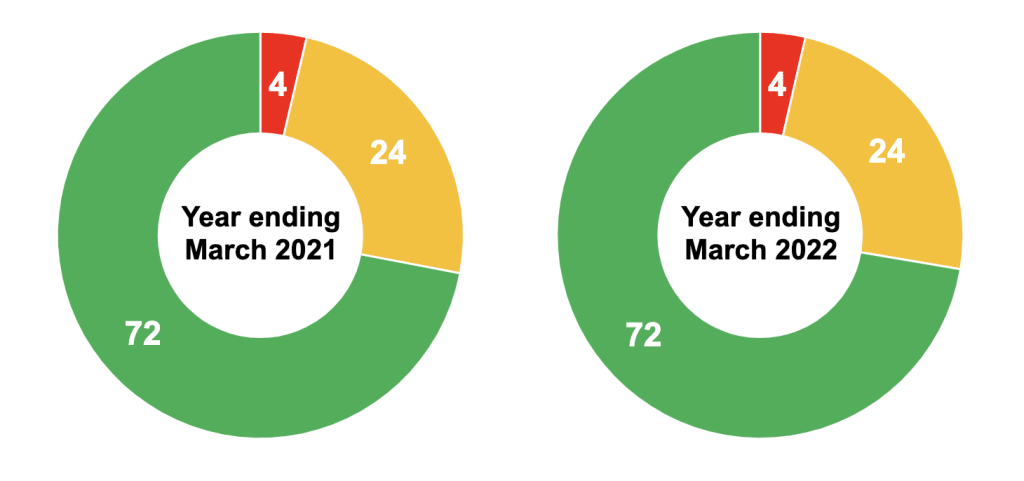A third of local ‘B’ and ‘C’ roads in the UK are in poor condition, while over a quarter of ‘A’ roads are also in need of maintenance, according to new statistics released by the Department for Transport (DfT).
Poor road conditions can lead to potholes, as tarmac and concreate opens up due to colder weather. This can cause an increase in vehicle damage, especially wheel alignment and suspension. The DfT reported covers the state of roads around the country up to the year ending March 2022.
The figures show that 6% of B and C roads, and 4% of A roads, are classified red, meaning they are in urgent need of repair. For the more rural roads, this figure has remained constant since March 2015, highlighting that more needs to be done to ensure repairs are carried out as soon as possible. The number of A roads classified red has remained the same as 2021, although the figure has increased compared to 2020.
Percentage of Local Authority managed ‘B’ and ‘C’ roads that are categorised as red, amber or green, in the years ending March 2020 and March 2022

Percentage of local ‘A’ roads categorised as red, amber, or green in the years ending March 2021 and March 2022

On the Strategic Road Network, which covers motorways and faster A roads, 11% should have been considered for maintenance, including 4% of motorways.
Potholes a menace to drivers
According to the latest RAC Report on Motoring, local road maintenance remains a prominent issue. Only 4% of drivers believe the state of roads in their areas have improved in the past 12 months, down from 6% a year ago. Meanwhile, 60% say conditions are worse, a 2% increase. The issue has been overtaken by increasing fuel prices as the most concerning trait for drivers, but remains extremely high in the list.
Issues with road surface quality are the main reason drivers say conditions have deteriorated (98%). But potholes are no longer the only problem, as 63% said they have noticed faded road markings, up from 56% last year, while 42% reported worsened signage visibility and 35% complained about the amount of litter by the roadside. Lack of grass and foliage maintenance is another problem, cited by 30% of drivers.
Data gathered by RAC Breakdown supports these views, with the company’s patrols attending more than 12,000 incidents related to potholes in 2021, the highest total recorded since 2018. However, with drivers increasingly putting off vehicle maintenance and repairs, issues related to potholes could go unchecked for quite some time, increasing the number of dangerous vehicles on UK roads.
Meanwhile, the RAC Pothole Index, which analyses pothole-related breakdowns together with the seasonal effects of the weather to give a true long-term indication of the condition of the UK’s roads, now stands at 1.63, up from 1.48 at the end of September 2021. This means that drivers are over one-and-a-half times more likely to break down after hitting potholes today than when the RAC began collecting this data in 2006.
The 2022 edition of the annual survey carried out by the Asphalt Industry Alliance (AIA) once again indicates that local authorities in England and Wales do not have the funding to keep roads in a reasonable condition. The AIA’s current Annual Local Authority Road Maintenance (ALARM) report states that despite a 4% increase in average highway maintenance budgets, councils are investing less money in carriageway repairs. As such, the reported backlog of repairs has increased by almost 25% to over £12 billion, according to the AIA’s estimates, this will take more than a decade to complete.
The country’s worst roads
According to the AA, which has analysed the DfT report, Derbyshire Council has the worst B and C roads, with 24% in need of repair. A fifth of B and C roads in Southend-on-Sea (18%) should be considered for repair, with Shropshire and Derby tied for third place with 13%.
Unclassified roads make up three fifths of roads maintained by councils but are the most overlooked. AA analysis has found that 15% of unclassified roads are considered “Red” category, the worst ranking available.
Half of unclassified roads in Hammersmith & Fulham are in need of repair, while more than a third of unclassified roads in Bury and Wolverhampton need resurfacing.
The data comes with the Prime Minister and Chancellor due to announce their fiscal statement later this month, but with rumours swirling about public spending cuts. The AA is warning the government that cutting funding for roads maintenance would be detrimental for everyone.
“Roads across the country are in an awful state and with winter just around the corner the plague of potholes will only spread,” commented Jack Cousens, Head of Roads Policy for the AA. Local roads are at great risk of becoming dangerous and need significant invest to make them safe. Smooth roads also encourage people to cycle more which would help reach our net-zero targets.
“Our local roads cannot take another round of cuts. The Prime Minister and Chancellor should avoid slashing local road investment.”




You must be logged in to post a comment.